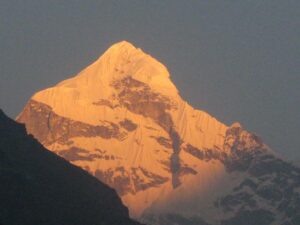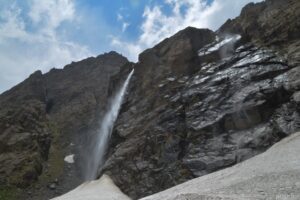Char Dham Yatra 2024: Badrinath Dham has an ancient temple and is the place where divinity is combined with the peace of nature and is a temple of Sanatan Dharma.
It is situated at an altitude of 3,133 meters in Chamoli district of Uttarakhand in Badrinath Dham Devbhoomi. It is the main abode of Lord Vishnu and is one of the most sacred pilgrimage sites of Char Dham Yatra pilgrimage in India. And other Char Dham sites also include Dwarka Puri and Rameshwaram|

Nar and Narayan are situated between some peaks. And it is also related to Chhota Char Dham in Uttarakhand, the holy place of Lord Vishnu. Badrinath Dham is the last and most famous stop of the Gadwal Himalayan pilgrimage starting from Yamunotri, Gangotri and Kedarnath Baba. And Bagrinath Dham can be easily reached by motor vehicle and also by roads. Char Dham Yatra |
Anyone can easily reach Shri Badrinath Dham Ji Temple on foot. No old person can be sent anything. And about 3 km away from Badrinath Dham is Mana village, which is one of the last villages before the border of Tibet starts even after the border of India ends. And the peak of Neelkanth stands out spreading its powerful aura for all pilgrims and travelers alike.
Shri Badrinath Dham is a land of innumerable legends. Each of which also enhances the glory of this place. This coupled with legends and snowy mountains and peaks, beautiful flowing Alaknanda River and incredible landscape makes it the perfect breeding ground to facilitate spiritual connection and it is the birthplace of a goddess.
Shri Badrinath Dham Temple opening dates 2024.
The holy temple of Badrinath Dham in Dev Bhoomi Uttarakhand is going to open for pilgrimage on 12 May 2024.
Location, Architecture and Temple of Badrinath – Char Dham Yatra
There is a rectangular place called Talab near which there is a house and people are taking bath in the hot spring.
A hot spring next to the Badrinath temple is a hot water spring, and bathing is done inside the house. This temple is situated in the Garhwal hilly areas near the Alaknanda river in the Chamoli district of Devbhoomi Uttarakhand. This hilly area is situated about 3,133 meters and 10,279 feet above the mean sea level. Nar Parvat is situated in front of the temple. Whereas Narayan Parvat is situated behind Neelkanth Shikar.

Adi Shankaracharya had established Badrinath as a pilgrimage site in the ninth century and the temple has three structures. Darshan Mandap and Sabha Mandap The conical shaped roof of the sanctum sanctorum is about 15 meters and 49 feet high, and is topped by a small dome and covered with a gold roof. Its apse is made of stone and has an arched player. And a very wide arch leads up to the main door or entrance, a tall arched entrance. And just inside it is a pavilion, a large pillared hall which leads to the sanctum sanctorum or the main temple area. The walls of the hall are covered with carvings.
The main temple has a 1 feet 0.30 meter Shaligram deity of Badrinath Narayan. Which is on a golden canopy under the Badri tree. And the deity of Badrinarayan is shown with two of his hands holding a conch and a chakra and his other thing or two hands placed in his lap in Yogamudra. And in the Grabhagraha there is the image of Lord of wealth Ji and Kuber, Rishi or Nara and Narayana.
There are fifteen more idols around the temple which are also worshipped. It includes the manifestations of Lakshmi and Gurudwara and Navadurga, nine different Durgas. There is also a temple of Lakshmi Narasimha Devta ji and temples of Saint Shankaracharya ji, Nar Narayan, Ghantakarna. And the idols of all the gods are made of black stone.
Tapt Kund, a group of hot sulfur springs immediately below the temple and which are also considered medicinal, is considered necessary for many pilgrims to bathe in the springs before visiting the temple. The temperature of the waterfall is 55 degrees Celsius throughout the year. Whereas the temperature of that load generally remains below 17 degrees throughout the year. And the two water ponds in the temple are also called Narad Kund and Surya Kund| Char Dham Yatra |
History
There are not many historical records about the temple. But there is mention of Istadev Badrinath in Vedic texts. And according to some accounts, this temple has been worshiped in some form or the other since the Vedic period. And during the reign of Ashoka, due to the spread of enlightenment and religion, this temple has been converted into a Buddhist temple.
Char Dham Yatra – This temple was an eighth century old temple and Adi Shankaracharya had also renovated this temple and converted it into a Hindu temple. And the architecture of the temples resembles a Buddhist monastery. And it is believed that Shankar resided at this place for six years from 814 to 820 AD. And Hindu followers claim that he discovered the Badrinthji deity of the Alaknanda river and also installed it in a cave near the Tapt Kund hot spring.

The throne of Badrinath ji was also named after Eastdev and the king received the key for ritual worship from the devotees before visiting the temples. This practice continued till the end of the 19th century. And during the 16th century, the Raja of Gadwal got it shifted to the present temple.
when the Garhwal state was divided, the Badrinath temples came under British rule and also became the chairman of the Raj Management Committee of Garhwal. The priest is also selected, which was done among the Garhwal and Travancore royal families.
During 2006, the Uttarakhand state government declared the districts around Sri Badrinath as a no construction zone to prevent illegal encroachment.
legend
According to Hindu mythology, Shri Vishnu used to sit in meditation at this place. In the midst of his meditation, Shri Vishnu was unaware of the cold weather. His religious wife Lakshmi ji protected him in the form of Badri tree. And pleased with the devotion of Goddess Lakshmi, Lord Shri Hari named that place Badrikashram. According to Atkinson, the place was earlier a plum fruit forest.
Which is not found there today, in the temple Lord Vishnu is depicted sitting in Padmasana posture in the form of Badrinath. And during the mythological story, sage Narad had punished Lord Vishnu. Who saw Vishnu’s wife Lakshmi massaging his feet. Went to Badinath Dham to meditate for a long time in Padmasana or for penance.

Char Dham Yatra – Shri Vishnu Ji Purana also tells another version of the origin of Badrinath. According to tradition, Yamraj had two sons, and these are the modern names of the two Himalayan mountains. Both of them chose a place to spread their religion, and each of them chose the vast expanses of the Himalayas.
Looking for an ideal place to establish the ashram, they came across the other four Badris of the five Badris, namely Bardha Badri, Yoga Badri, Dhyan Badri, and Bhavish Badri. And they had a hot and cold spring near the Alaknanda river which was named Badri Vishal | Char Dham Yatra |
Pilgrimage
Devotees of all religions and all schools of Hinduism come to Badrinath Temple. And all the major monastic institutions like Kashi Math, Jiyar Math, and Mantralayam Sri Raghavendra Swamy Math have their own branches and guest houses and everyone rests there. Char Dham Yatra |
Shri Badrinath Dham Panch Badri Namak is one of the five associated temples dedicated to the worship of Hari Narayan. The huge five ancient temples – Badrinth temple in Badrinath Dham, and Yogdhyan Badri situated in Pandukeshwar, Bhavishya Badri situated at 17 km from Jyotimarth in Suben, Vriddhabadri situated at 7 km from Jyotimarth in Animath and Adi Badri situated at 17 km from Karanprayag are considered to be the most famous temples.
It is considered one of the holy Hindu Char Dham sites. Which includes Rameshwaram, Badrinath Puri and Dwarka. While the origin of the temple is not clearly known.
The Advaita school of Hinduism, founded by Adi Shankaracharya, attributes the origin of Char Dham to the seer. And four monasteries are present in four corners of India.
Festivals and Hindu religious practices
Char Dham Yatra – The most important and major festival organized in the Badrinath temple is the fair of Mata Murti, which commemorates the descent of Mother River Ganga on earth and is also believed to be the birth anniversary of Mother Badrinath, who brought out a river for the welfare of earthly beings. Divided into channels. Pooja and Aarti are performed during the festival. And the place where the river keeps flowing has become the holy land of Badrinath.
Badri Nath Kedar Utsav is celebrated in both the temple and Kedarbaba temple in the month of June. And people celebrate these festivals well. This festival continues for eight days. And during the ceremony, artists from all over the country will perform.
The major religious activities or Kuchi performed every morning are Mahabhishek or Abhishek, Gita recitation and Bhagwat puja. Evening puja includes Gita Govinda and Aarti. Everyone performs this puja with full devotion.
Vedic scripts like Ashtotram and Sahasranama are also recited during all the rituals. And after Aarti Puja, the decoration is removed from the image of Badrinath Dham and that sandalwood paste is applied.

It is also given as Prasad to the devotee during Nirmalya Darshan on the very next day. And this is done in front of all the devotees. , unlike some Hindu temples, where some practices are hidden from them. And sugar balls and dry leaves are given to the devotees. From May 2006, the practice of offering prasad prepared locally and packed in local bamboo baskets was started|
Kedarnath temple is closed for winter on the auspicious day of Bhatrivitiya and thereafter during October or November because at that time it is very cold in Kedarnath and Badrinath temples. On the concluding day Akhand Jyoti, a lamp filled with ghee is lit. It keeps burning for six months.
On that day, a special puja is performed by the chief priest in the presence of pilgrims and temple officials and during this period the Badrinath image was shifted to the Narasimha temples of Jyotimath, located 40 miles away from the temple. And the temples are refurnished on Akshaya Tritiya around April-May. is another auspicious day in the Hindu calendar. On the very first day of opening of the temple after winter, pilgrims gather to see Akhand Jyoti.
Char Dham Yatra – This Badrinath temple is one of those holy places where Hindus offer offerings to their ancestors with the help of pundits. Devotees worship before the image of Badrinath in the sanctum sanctorum of the temples and come to take a holy bath in the Alaknanda River. The common belief is that taking a dip in the pond purifies the soul.
Mythological story of Shri Badrinath Dham
1) Badrikashram
Badrinath is one of the most mythological temples, many mythological stories are associated with it and it has many secrets. According to a legend, Lord Vishnu had performed rigorous penance at this place. During his deep meditation, he was unaware of the severe weather conditions. To save him from the scorching heat of the sun, his wife Goddess Lakshmi took the shape of the Badri tree. And it spread over them. Seeing all this, Lord Vishnu was pleased with their devotion and hence he named the place Badrikashram |
2) Shri Hari Narayan Ji’s desire to meditate in Badrinath Dham.
It is also said in another legend that. Lord Shiva and his Sati Devi Parvati were once performing penance in Badrinath. And then Shri Narayan Bhagwan Ji had come there in the form of a small child and had disturbed them by shouting loudly. And hearing this, Goddess Parvati ji asked him the reason for his sorrowful behavior. So he replied that he wanted to meditate in Badrinath. When Lord Narayan ji was discovered in disguise, Mahadev and his Sati left Badrinath and went to Kedarnath.
3) Stories of Nar and Shri Narayan ji.
Shri Badrinath Dham relates the story of two sons of Dharma, Nar and Narayan who wanted to establish their own ashram amidst the sacred Himalayas and also expand their religious base. According to legends, while searching for a suitable place for his ashram, he also accidentally discovered the four sites of Panch Badri, Dhyana Badri and Yoga Badri, Bradha and Bhavishya Badri.
Finally they found a place where there were two attractive cold and hot springs behind the Alaknanda River. And he was very happy and pleased after finding this place and thus he named this place Badri Vishal and thus Shri Badrinath Dham temple came under the blessings.
4) Neelkanth Peak

Known as the Queen of Devi Bhoomi Garhwal, Neelkanth Peak with its towering height of 6,597 meters forms an important backdrop to the Shri Badrinath Temple. The beauty of this snow covered peak, named after Mahadev Ji, increases further. And first thing in the morning, when the first ray of Sun falls, it is a wonderful sight.
5) Vasundhara Falls

Situated in the serene Himalayas, this 122 meter high waterfall can be reached by 3 km road or vehicle (up to Mana village) and by walking 6 miles on foot. You will not face any problem on the way.
6) Mata Murti Temple
It is situated on the banks of Alaknanda River, just 3 km from Badrinath Temple. And it is also believed that Mata Murti Temple is the mother of Lord Vishnu’s twin brother incarnations Nar and Narayan and this was the continuous prayer of Mata Murti. Who had convinced Lord Vishnu to take birth from her womb. Another year, in September, pilgrims go to Mata Murti and a fair is held there. People also participate there. Char Dham Yatra
7) Charanpaduka
Also full of stones and caves, a very steep climb of more than 3 km from Badrinath Dham will take you to the Charanpaduka Temple. And this is a rock which is also believed to have the footprints of Lord Vishnu on it because he had descended on earth from Vaikuntha.
8) Sheshnetra
Between these two seasonal lakes and opposite to Alaknanda, there is a big rock which also gives the impression of shesh Nag, the mythological snake of Shri Vishnu. And there is also a natural mark on the remaining eye. Which looks just like the eyes of Shesh Naag. And it is also believed that Nag Badrinath, 1.5 km away from the temple, is protecting the holy temple.
How to reach Shri Badrinath Dham?
route

From Haridwar to Rishikesh then from Devprag to Kirtinagar and from Srinagar to Rudraprayag then from Gauchar to Karnaprayag then from Nandprayag to Chamoli then from Birahi to Pipalkoti then from Garud Ganga to Helang, then Joshimath, Vishnuprayag, Govidghat, Pandukeshwar, Hanumanchatti, Badrinath Dham will fit.
By air:
Till Jolly Grant Airport and then via Rishikesh Road to Dehradun, then Gangotri is the nearest airport. And after that you can take a Bolero or a bus from here. Char Dham Yatra
by train :
Regular trains from Haridwar to Dehradun are available at all times of the year. And you can do this by any bulero or bus.
by bus :
Badrinath is well connected by motorable roads to important places of Uttarakhand and the roads there are good.

